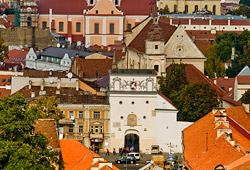History
In 1503, faced with Tatar attacks on Lithuanian lands and deteriorating relations with Russia, Lithuanian Grand Duke Aleksandras (1460–1506) granted Vilnius the privilege of building stone fortifications around the entire city. It is said that the cornerstone of the defensive wall was laid in the spot where the road leaves town in the direction of Medininkai and Minsk. The blessing of this stone began the construction of what would eventually become the Gate of Dawn.
The gate, which now houses a chapel with a painting of the Mother of Mercy, was first mentioned in 1514 and referred to as the Medininkai Gate. In documents from 1594, we find the Latin name Porta Acialis, and the Polish equivalent Ostra brama, which translate as “the Sharp Gate”. It is not known why the gate was given this name. Lithuanians in the Vilnius region used the name Ašmens vartai (“Gate of the Blade”). Some suspect this was a reference to the town of Ašmena, which got translated into Latin and Polish not as a place name, but literally. Nor is it known just when or why the Lithuanian name of Aušros Vartai (Gate of Dawn) was adopted. The term may draw on the Blessed Virgin Mary’s title of Morning Star (Aušros žvaigždė in Lithuanian). Or it may reflect the geographical orientation of this city gate, since the road that passed through it led south-east, the direction of the dawn.
Initially the Mother of Mercy painting hung in a small outdoor niche on the inside of the gateway. It complemented another painting entitled “Saviour of the World”. The image of Mary did not yet enjoy a special chapel or adornments like those of other miraculous images. And so things remained until the Discalced Carmelites arrived in Vilnius in 1626, and received land to build a monastery and church near the Gate of Dawn.
In 1654 the Carmelites consecrated the church, which they dedicated to St Teresa of Avila, a great Spanish mystic, guide for the spiritual life and Carmelite reformer. From the moment of their arrival in Vilnius, the Carmelites paid great attention to the painting that hung in the city gateway. They would organize prayer services by the image to encourage people’s piety. Then in 1668 the city authorities entrusted the Carmelites with the care of the painting of the Blessed Virgin, and in 1671 Father Charles of the Holy Spirit, a Carmelite, arranged the construction of a wooden chapel for the image.
When the Swedes occupied Vilnius in 1702, public devotion to the image was forbidden, as were all gatherings of people in the streets. The painting was damaged – pierced by a bullet – during fighting to regain control of the city gate. Fire ravaged the wooden chapel in 1711, leading to construction of the current brick chapel in 1712-1715. The chapel’s late classicist traits date to 1829. It was designed to allow believers to pray before the image from the street, since entrance was possible only from the monastery courtyard, where lay persons – especially women – were not allowed. In 1844, the Tsarist authorities drove the Carmelites out for having aided rebels in an uprising, giving their monastery over to Russian Orthodox believers. The chapel, meanwhile, was transferred to the control of diocesan Catholic clergy. That is when open access was given to pilgrims, who could (and still can) enter through an internal staircase-gallery built in 1789-1799, according to an architectural design by Pietro di Rossi.
The edifice containing the gateway and chapel was carefully restored in 2002, revealing decorative elements that had been painted over during the 19th century.








